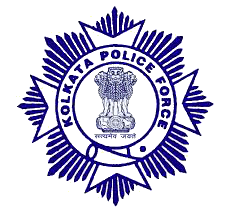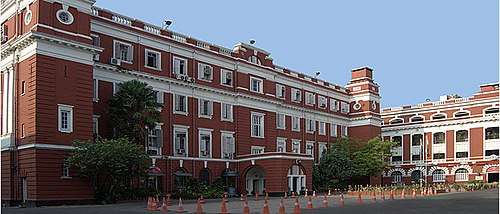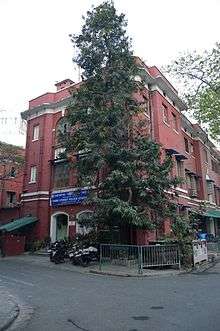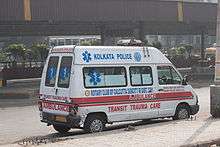Kolkata Police Force
| Kolkata Police Force | |
|---|---|
 logo of Kolkata Police | |
| Common name | Kolkata Police |
| Abbreviation | KP |
| Agency overview | |
| Formed | 1856 |
| Employees | 26,934 |
| Annual budget | ₹1,108 crore (US$150 million)[1] |
| Jurisdictional structure | |
| Operations jurisdiction |
Kolkata, |
|
| |
| Map of Kolkata Police Force's jurisdiction. | |
| Size | 311 sq mi (810 km2) |
| Population | 45,80,544 (within 200.71 km**) |
| General nature | • Gendarmerie• Civilian police• Secret police |
| Headquarters | 18, Lalbazar Street, Kolkata 700 001 |
|
| |
| Elected officer responsible | |
| Agency executive |
|
| Parent agency | Ministry of Home Affairs (West Bengal) |
| Facilities | |
| Stations | 79 [2] |
| Website | |
| www.kolkatapolice.gov.in | |
|
* As per 2001 Census **As per Penguin India Reference Yearbook 2007 edition | |

The Kolkata Police Force (KPF) is one of the two presidency police forces of the Indian state of West Bengal. Kolkata Police has the task of policing the metropolitan area of Kolkata (formerly Calcutta), India, as defined under the Calcutta Police Act, 1866 and the Calcutta Suburban Police Act,1866. The primary functions of the forces are maintaining law and order in the city, traffic management, prevention and detection of crime and co-ordinating various citizen-centric services for the people of Kolkata. As of 2017, Kolkata Police has 8 divisions covering 70 police stations. It has a strength of approximately 35,000 and a territorial jurisdiction of 243 km2 (approx). There are 8 battalions of armed forces as well as specialised branches. The force also uses various modern technologies for effective handling of unconventional crimes, terrorism and related activities.
History
Early years (17th century)
The history of the present structure of policing in Kolkata goes back to colonial times, when the city was known as "Calcutta", and was an early settlement of the English East India Company. Calcutta was founded on the eastern banks of the Hooghly by an Englishman, Job Charnock in 1690. Policing in Calcutta's earliest days was confined to the Mughal administration and their local representatives. Bengal was still technically a part of the Mughal Empire, but the Nawabs of Bengal, based in Murshidabad in North Bengal, were its effective rulers. The watch and ward functions were entrusted to a Kotwal or town prefect who had 45 peons under him, armed with traditional weapons like staves and spears, to deal with miscreants.[3]
Colonial Police (1720 - 1845)
In 1720, the East India Company formally appointed an officer to be in charge of civil and criminal administration. He was assisted by an Indian functionary commonly known as black deputy or black zamindar. Under him were three naib-dewans, one of whom was in charge of the police. The settlement was divided into "thanas" (police stations) under "thanadars" who had in turn contingents of "naiks" and "paiks". A small contingent of river police was also formed. A statute passed in 1778 raised the strength of the police in Calcutta to 700 paiks, 31 thanadars and 34 naibs under a superintendent. In 1785 commissioners of conservancy were appointed for the town who also looked after watch and ward. Policing was still very loosely organised. In 1794, justices of peace were appointed for the municipal administration of Calcutta and its suburbs, under a chief magistrate who was directly in charge of the Police. In 1806 justices of peace were constituted as magistrates of 24 Parganas and parts of the adjacent districts within a 20-mile radius of the town.[4]
Consolidation (1845 - 1866)
The middle decades of the 19th century witnessed a greater systematisation and institutionalisation of policing in Calcutta. A city magistrate named William Coats Blacquiere inaugurated a network of spies or goendas (Bengali: গোয়েন্দা). In 1845 a committee under J.H. Patton brought about key changes in police organisation which now began to be modelled on the London Metropolitan Police. A Commissioner of Police was appointed with powers of a justice of peace to preserve law and order, detect crime and apprehend offenders. In 1856 the Governor-General promulgated an Act treating the Calcutta Police as a separate organisation and S. Wauchope, who was then the chief magistrate of Calcutta, was appointed as the first Commissioner of Police.[5]
1857 was a difficult time for the English East India Company. The year saw the first upsurge against British rule. The rebellion led to the dissolution of the East India Company in 1858. It also led the British to reorganise the army, the financial system and the administration in India.[6] The country was thereafter directly governed by the crown as the new British Raj. Commissioner Wauchope handled the situation ably and was knighted for his achievement. During the incumbency of his successor V.H. Schalch the Calcutta Police Act and the Calcutta Suburban Police Act were enacted in 1866.
Modernisation (1866 - 1947)
In 1868, Sir Stuart Hogg set up the Detective Department in Calcutta Police with A. Younan as the superintendent and R. Lamb as the first-class inspector. Hogg was both the Commissioner of Police and the Chairman of the Calcutta Municipal Corporation. Sir Fredrick Halliday, who was appointed as the Commissioner of Police in 1906, also introduced several changes in the administration of Calcutta Police including the system of running a Control Room. In response to the threat of the nationalist organisation Anushilan Samiti, Haliday oversaw the creation of the Special Branch in June 1909 on the recommendation of Sir Charles Augustus Tegart. For his numerous contributions to the growth of the city police, he is regarded as the father of modern Calcutta Police.[7] Sir Charles Augustus Tegart headed the Detective Department was the first cadre of the Indian Police (IP) force in the organisation. He reorganised the city police force and made it efficient. A highly decorated officer, he was the Commissioner of Police from 1923–31 and was admired for keeping the city free from crime. However, he was unpopular with freedom fighters and his encounters with revolutionaries are a part of popular Bengali folklore. The same time saw the rise of three Bengali police officers named Ramgati Banerjee, Sukumar Sengupta and Zakir Hussain. During the Salt March movement in 1930, the Calcutta Police was headed by Charles Tegart as Police Commissioner, Ramgati Banerjee as DC (South) and Sukumar Sengupta as DC (North). Later, Banerjee left his position and took up teaching as a profession, and Hussain left the job to become the First Governor-General of East Pakistan. Sukumar Sengupta continued in the job to become the first Bengali Inspector General of Police, West Bengal soon after independence.
Post-independence (1947 onward)
The colonial history of the Calcutta Police force was primarily repressive and anti-nationalist. After India gained independence from British rule in 1947, Calcutta Police was re-organised as an essential element of the Indian law enforcement agencies. Surendra Nath Chatterjee was the first Indian Commissioner of Police. As of 2014, Kolkata Police has 8 divisions covering 70 police stations. It has a strength of approximately 35,000 and a territorial jurisdiction of 243 km2 (approx). There are 8 battalions of armed forces as well as specialised branches.
Logo
Each symbol of the Kolkata Police seal has a special significance. At the centre is the Ashok Stambha, which has been adopted from Ashoka's Sarnath Lion Capital. The 24-spoked wheel is referred to as the Dharmachakra. Dharma or religion is the manifestation of the inner conscience and as Swami Vivekananda said: "Religion is the manifestation of the divinity already in man". Below the Dharmachakra is inscribed "Satyameva Jayate" which signifies that Truth always prevails. In between the two circles, which encircle the Ashok Stambha, is the symbolic peacock, which is the national bird. The seal signifies upholding truth, valour and justice. "We who enforce the law must not merely obey it. We have an obligation to set a moral example, which those whom we protect can follow."
Organizational structure
As of 2014, Kolkata Police has 8 divisions covering 69 police stations.[8] It has a strength of 29,973 and a territorial jurisdiction of 243 km2. The Commissioner is the chief of the Kolkata Police. The commissioner is appointed by the Government of West Bengal and reports independently to the Home Secretary of the State. The headquarters are at 18, Lalbazar Street, near B.B.D. Bagh area in Central Kolkata. The commissioner is an Indian Police Service officer of the rank of Additional DG & IG of police. Shri Rajeev Kumar IPS is the present commissioner.
Units
|
|
|
Rank structure
The rank structure of Kolkata Police officers is as follows (in descending order of seniority):
- Commissioner of Police
- (One) Special Commissioner of Police
- (Six) Additional Commissioners of Police
- (Five) Joint Commissioners of Police
- Deputy Commissioners of Police
- Assistant Commissioners of Police
- Inspectors
- Sub-Inspector/Wireless Supervisor/Sergeant
- Assistant Sub-Inspector
- Naik
- Constable/Sepoy
- Wireless Helper
Jurisdiction
The jurisdiction of the Kolkata Police covers the area of Kolkata District and an adjacent area as well. That adjacent area, like Kolkata District, is within the boundaries of the Kolkata Municipal Corporation. The Kolkata Police's entire area comprises all 144 wards of the KMC.
Administration
- I. Particulars of the Kolkata Police Commissionerate, functions and duties
Commissioner of Police, Kolkata, is the Executive and Administrative Head of Kolkata Police Force . Under his command and control[10] , there are:
| Rank structure of the Kolkata Police[9] | |||
| S no. | Rank | Sanctioned Strength | Present Strength |
| 1 | Commissioner of Police | 1 | 1 |
| 2 | Spl. Commissioner of Police | 1 | 1 |
| 3 | Addl. Commissioner of Police | 3 | 3 |
| 2 | Spl. Addl. Commissioner of Police & Jt. Commissioner of Police | 5 | 5 |
| 4 | Jt. Commissioner of Police | 5 | 4 |
| 5 | Dy. Commissioner of Police | 34 | 26 |
| 5 | Dy. Commissioner of Police (Women) | 1 | 1 |
| 6 | Asstt. Commissioner of Police | 147 | 135 |
| 7 | Asstt. Commissioner of Police (Women) | 4 | 4 |
| 7 | Police Prosecutor | 42 | 32 |
| 8 | Inspector of Police | 613 | 604 |
| 9 | Inspector of Police (Armed) | 10 | 0 |
| 10 | Inspector of Police (Female) | 18 | 17 |
| 11 | Sub-Inspector of Police | 1865 | 1498 |
| 12 | Sub-Inspector of Police (Female) | 143 | 113 |
| 13 | Sub-Inspector of Police (Armed) | 70 | 0 |
| 14 | Sergeant | 1617 | 1223 |
| 15 | Sergeant Major | 29 | 2 |
| 16 | Subedar | 150 | 63 |
| 16 | W/Sgt./Supvr. | 14 | 0 |
| 16 | W/Supvr./Gr - I | 13 | 12 |
| 16 | W/Supvr./Gr. - II | 53 | 18 |
| 16 | Supernumerary ASI | 325 | 325 |
| 17 | Asstt. Sub-Inspector | 2917 | 2884 |
| 16 | Supernumerary L/ASI | 5 | 5 |
| 18 | Asstt. Sub-Inspector (Female) | 131 | 131 |
| 19 | Asstt. Sub-Inspector (Armed) | 1605 | 1019 |
| 16 | ASI, Photographer | 1 | 1 |
| 20 | Head Farrier | 1 | 0 |
| 16 | Head Police Driver | 9 | 0 |
| 16 | Head Sower | 5 | 5 |
| 22 | Women Constable | 910 | 444 |
| 23 | Farrier Constable | 1 | 0 |
| 24 | Constable or Sepoy | 21571 | 16743 |
| 25 | Police Driver | 1740 | 1415 |
| 24 | Sower | 85 | 45 |
| 24 | Majhi/Dandi/Sarang/Engine Driver | 8/40/9/9 | 1/33/3/5 |
| 24 | Greaser/Laskar/Sukhani/Armourer | 6/16/3/73 | 4/5/0/0 |
| 24 | Syce/Wireless Helper | 98/54 | 67/37 |
| Total | 34460 | 26934 | |
- Alipore
- Amherst Street
- Amherst Street Women
- Anandapur
- Ballygunge
- Bansdroni
- Behala
- Behala Women
- Beliaghata
- Beniapukur
- Bhowanipur
- Bowbazar
- Burrabazar
- Burtolla
- Charu Market
- Chetla
- Chitpur
- Cossipore
- Ekbalpur
- Entally
- Garden Reach
- Garfa
- Gariahat
- Girish Park
- Hare Street
- Haridevpur
- Hastings
- Jadavpur
- Jorabagan
- Jorasanko
- Kalighat
- Kolkata Leather Complex
- Karaya
- Karaya Women
- Kasba
- Lake
- Maidan
- Maniktala
- Metiabruz
- Muchipara
- Nadial
- Narkeldanga
- Netaji Nagar
- New Alipore
- New Market
- North Port
- Panchasayar
- Park Street
- Parnashree
- Patuli
- Patuli Women
- Phoolbagan
- Posta
- Pragati Maidan
- Purba Jadavpur
- Rabindra Sarobar
- Rajabagan
- Regent Park
- Sarsuna
- Shakespeare Sarani
- Shyampukur
- Sinthee
- South Port
- Survey Park
- Tala
- Taltala
- Taltala Women
- Tangra
- Taratala
- Thakurpukur
- Tiljala
- Tollygunge
- Tollygunge Women
- Topsia
- Ultadanga
- Ultadanga Women
- Watgunge
- Watgunge Women
- West Port


See also
References
- ↑ "Information regarding Kolkata Police under RTI Act" (PDF). Kolkata Police. Retrieved 27 April 2014.
- ↑ http://timesofindia.indiatimes.com/city/kolkata/Kolkata-to-get-eight-more-police-stations/articleshow/38039369.cms
- ↑ "Origins of Kolkata Police". Kolkata police. Retrieved 27 April 2014.
- ↑ "Consolidation of the Police Force". Kolkata police. Retrieved 27 April 2014.
- ↑ "Colonial History of the Kolkata Police". Kolkata Police. Retrieved 27 April 2014.
- ↑ Bayly 1990, pp. 194–197
- ↑ "Colonial History of the Kolkata Police". Kolkata Police. Retrieved 27 April 2014.
- ↑ Ghosh, Dwaipayan (27 February 2014). "Four new police stations in Kolkata". The Times of India. Retrieved 27 April 2014.
- 1 2 "Right to Information" (PDF). Kolkata Police.
- ↑ http://www.kolkatapolice.gov.in/images/docs/rti.pdf
- ↑ http://www.kolkatapolice.gov.in
- ↑ http://www.kolkatapolice.gov.in/images/docs/rti.pdf
- "Evolution of the Calcutta Police: A Calcutta Police presentation on the occasion of the Calcutta Tercentenary, 1990", Calcutta Police, 1990
External links
| Wikimedia Commons has media related to Kolkata Police. |
